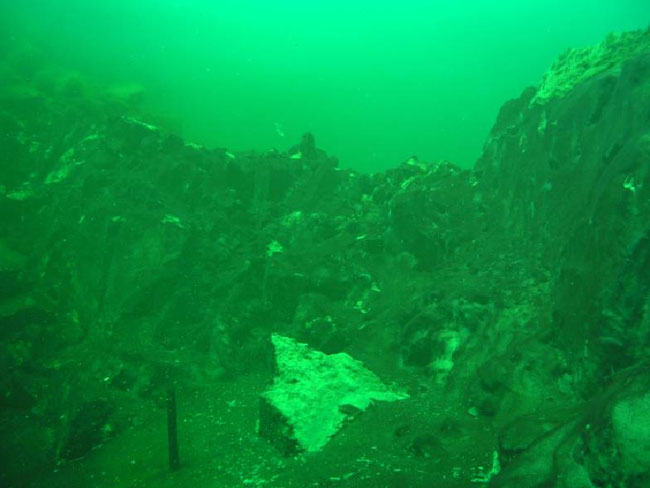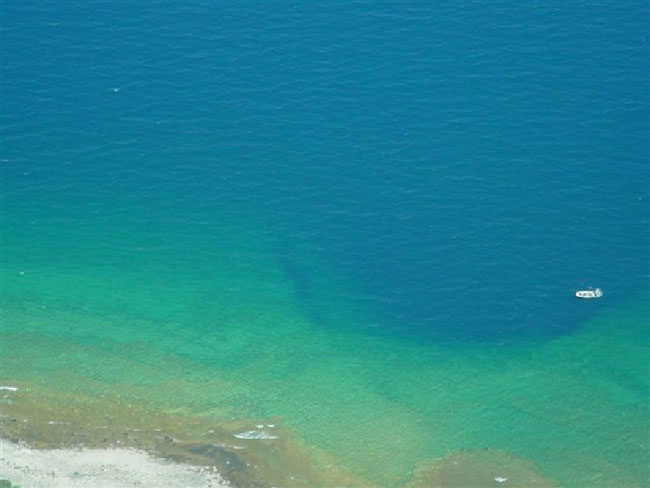Strange life form in the Great Lakes
Scientists have discovered some strange life forms at Lake Huron. Strange geological formations are enabling the floating carpet of bacteria to grow in the Great Lakes, the researchers said. This strange biology resembles what is found in the harshest environments on Earth.
The microbial carpet lies at a depth of 66 minutes (20 meters) below Lake Huron's surface - the third largest lake in the Great Lakes system in North America - where researchers have discovered sinkholes due to decay of the part of the ancient seabed underneath.
Around these sinkholes are purple cvanobacteria mats - a relative of the bacteria found at the bottom of the permafrost lake in Antarctica - and pallid , a floating form of another bacterium. The water in this area is dense, salty and free of oxygen, so it is not suitable for most of the larger and more familiar forms of life in the lake.

Water samples from one of the sinking areas near the area of pure groundwater, facilitating the development of purple cyanobacteria.(Photo: Russ Green, Thunder Bay National Headquarters)
Scientists report that some star dumps act as pans containing dead and rotten plants as well as decomposing animals, while collecting a layer of sediment with micro bacteria located above.
This medium is similar to the environment around deep-sea hydrothermal vents where many strange life forms have been discovered.
In an oxygen-free water environment, cyanobacteria perform photosynthesis using sulfur compounds, not water, and produce hydrogen sulfide, which has a smell of rotten eggs. Where the sinking holes are deeper and there is no light at all, microorganisms do not use photosynthesis but use chemical tools to metabolize sulfur nutrition.

The middle of the island has facilitated the formation of biological activities at Lake Huron.A 29.5 minute (9 meter) whale hunting boat is also observed on this photo.(Photo: Scott Kendall and Bopi Biddanda, Grand Valley State University)
Groundwater under Lake Huron is decomposing minerals from the sea floor no longer exists and bringing them into the lake to form the environment of harsh and exotic environments, Bopaiah A. Biddanda of Grand Valley State University, in Muskegon , Mich said. Biddanda was one of the people leading the study of these strange environments.
Steven A co-author, Ruberg of the Lake Environmental Research Laboratory at the National Marine and Atmospheric Administration (NOAA), said: 'You have this ancient freshwater lake that contains materials 400 million years ago. . pushed into the lake '.
Biddanda, Ruberg, and colleagues are trying to figure out when the minerals were deposited and are now pushed into the lake.
The study, published in Eos, the American Geophysical Weekly magazine, 'may be a precursor to the discovery of new organisms as well as previously unknown biochemical processes. contribute to the discovery of life on Earth, ' concludes Biddanda.
- Discovering the 'ghost particle' - A strange form of life outside the universe
- 10 strange things happen every day without you knowing
- Archaeological evidence of human activity under Lake Huron
- 'Earth copy' is standard enough to form life!
- America: Detecting an odd circle on the ice lake
- Great Rift Valley Rift Great Rift
- Detecting traces of alien life
- Mars may have had many lakes filled with water for 10,000 years
- The phenomenon of 'ice volcano' on the lake
- 'Unbelievable' 13 strange facts about the Earth
- Blood-sucking fish slaughtered native creatures in Lake My region
- Detecting chemicals is thought to form life
 Surprised: Fish that live in the dark ocean still see colors
Surprised: Fish that live in the dark ocean still see colors Japan suddenly caught the creature that caused the earthquake in the legend
Japan suddenly caught the creature that caused the earthquake in the legend A series of gray whale carcasses washed ashore on California's coast
A series of gray whale carcasses washed ashore on California's coast Compare the size of shark species in the world
Compare the size of shark species in the world